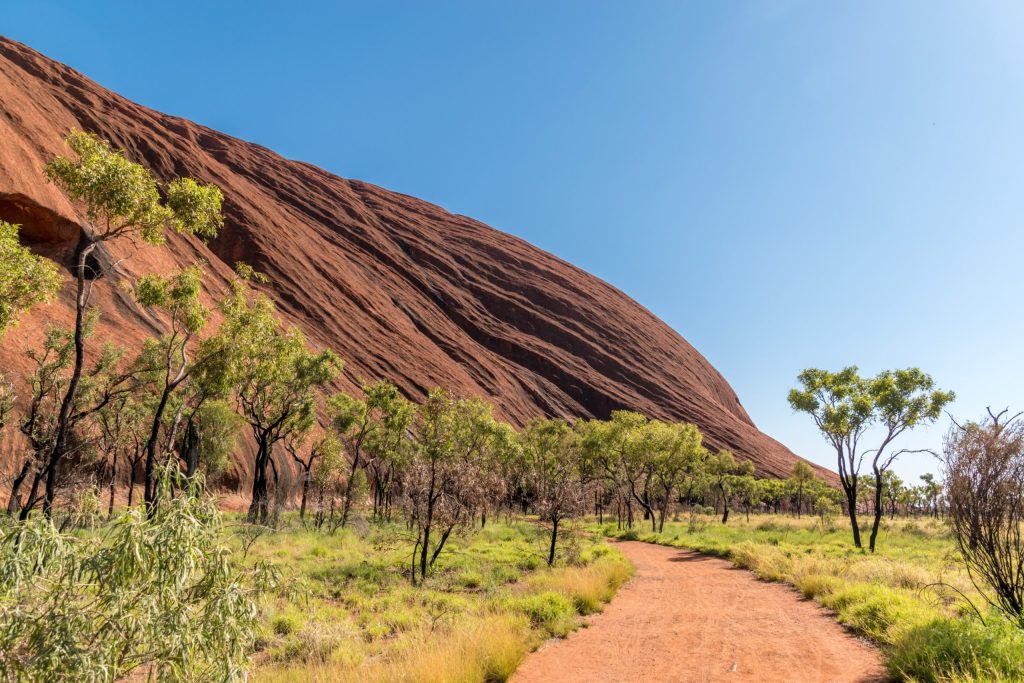Nestled in the heart of Australia’s vast outback, Uluru, also known as Ayers Rock, stands as an iconic symbol of the country’s ancient landscape and Indigenous culture. This majestic sandstone monolith rises dramatically from the flat desert floor, captivating visitors with its changing colours and spiritual significance. A visit to Uluru is not just a sightseeing experience; it’s a journey into the heart and soul of Australia’s red centre.
An Icon of the Outback
Uluru is a UNESCO World Heritage-listed site and one of Australia’s most iconic landmarks. Rising approximately 348 meters above the desert floor, it stretches for about 3.6 kilometres in length and 2 kilometres in width, making it one of the world’s largest monoliths.
What makes Uluru so unique is not just its immense size but also its ever-changing appearance. As the sun moves across the sky, the rock’s iron content reacts with the light, causing the colours to shift from ochre red to fiery orange and intense purple at sunrise and sunset. These magical moments, known as “the Field of Light,” create an otherworldly atmosphere that has to be experienced to be fully appreciated.
Cultural and Spiritual Significance
Uluru holds deep cultural significance for the Anangu, the traditional custodians of the land. The Anangu are the Indigenous people of the region, and they have lived around Uluru for over 60,000 years. According to their creation stories, the landscape was shaped by ancestral beings during the Dreamtime, a period of creation when the world was formed.
Visitors to Uluru are urged to respect the cultural beliefs and practices of the Anangu people. As part of this, climbing Uluru was discouraged and has since been permanently closed as of October 2019. Instead, visitors are encouraged to take part in guided tours that provide insights into the history, cultural significance, and Tjukurpa (Aboriginal law and belief system) associated with this sacred site.

Uluru
Exploring the Base and Surroundings
The best way to experience Uluru is to take a walk around its base, which is approximately 9.4 kilometres long. The Mala Walk and the Kuniya Walk are two popular routes that offer close-up views of the rock’s impressive formations and ancient rock art. Along the way, you’ll discover sacred sites, waterholes, and unique flora and fauna that have adapted to the harsh desert environment.
The Mutitjulu Waterhole, located near the base of Uluru, is an oasis in the desert and holds great significance for the Anangu people. Guided tours often provide opportunities to hear traditional stories, learn about bush tucker (bush food), and gain a deeper understanding of the region’s cultural heritage.
Stargazing in the Outback
One of the most captivating experiences at Uluru is the stargazing opportunities in the clear outback skies. As evening falls, the vastness of the outback provides a perfect canvas for the celestial display above. Away from the city lights, the night sky comes alive with countless stars, planets, and the Milky Way in all its glory. Stargazing tours led by experienced guides provide insights into the Southern Hemisphere’s constellations and the cultural significance of the stars to the Anangu people.
Where to Stay
Visitors to Uluru have a range of accommodation options to choose from, catering to various budgets and preferences. Luxury resorts, eco-sensitive lodges, and campgrounds are available near the Uluru-Kata Tjuta National Park entrance. Staying at one of the accommodations within the park allows you to experience the magic of Uluru at different times of the day, including sunrise and sunset, without travelling far.
Practical Considerations
- The best time to visit Uluru is during the cooler months, from April to September when the temperatures are milder and more pleasant for outdoor activities.
- Bring plenty of water, a hat, sunscreen, and comfortable walking shoes, as the desert environment can be harsh.
- Respect the cultural significance of the area and adhere to any guidelines or restrictions set by the Anangu people and the park authorities.





